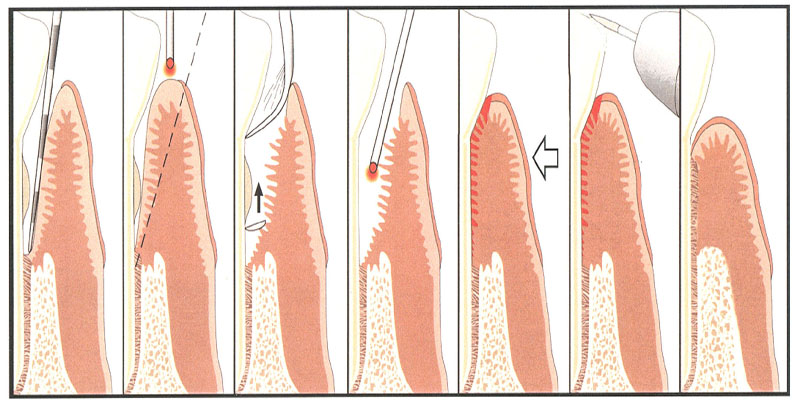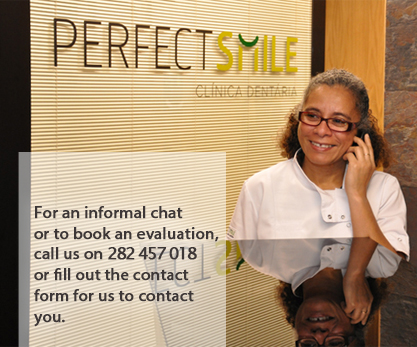 Treatment of Periodontal Disease
Treatment of Periodontal Disease
What does periodontal treatment involve?
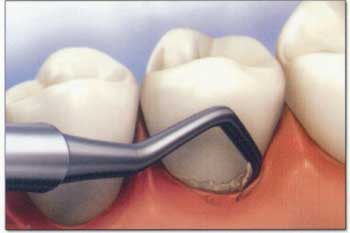 In the early stages, most treatment involves scaling and root planning - removing plaque and calculus around the tooth and smoothing the root surfaces. Antibiotics may be used to supplement the effects of scaling and root planning. In most cases of early gum disease, called gingivitis, scaling and root planning and proper daily cleaning achieve a satisfactory result. More advanced cases may require surgical treatment, which involves cutting the gums, and removing the hardened plaque build-up and recontouring the damaged bone. The procedure is also designed to smooth root surfaces and reposition the gum tissue so it will be easier to keep clean.
In the early stages, most treatment involves scaling and root planning - removing plaque and calculus around the tooth and smoothing the root surfaces. Antibiotics may be used to supplement the effects of scaling and root planning. In most cases of early gum disease, called gingivitis, scaling and root planning and proper daily cleaning achieve a satisfactory result. More advanced cases may require surgical treatment, which involves cutting the gums, and removing the hardened plaque build-up and recontouring the damaged bone. The procedure is also designed to smooth root surfaces and reposition the gum tissue so it will be easier to keep clean.
How do you prevent gum disease?
Removing plaque through daily brushing, flossing and professional cleaning is the best way to minimize your risk. Your dentist can design a personalized program of home oral care to meet your needs. If a dentist doesn't do a periodontal exam during a regular visit, the patient should request it. Children also should be examined.
Is maintenance important?
Sticking to a regular oral hygiene regimen is crucial for patients who want to sustain the results of therapy. Patients should visit the dentist every 3-4 months (or more, depending on the patient) for spot scaling and root planning and an overall exam. In between visits, they should brush at least twice a day, floss daily, and brush their tongue. Manual soft nylon bristle brushes are the most dependable and least expensive. Electric brushes are also a good option, but don't reach any further into the pocket than manual brushes. Proxy brushes (small, narrow brushes) are the best way to clean in between the recesses in the teeth, and should be used once a day. Wooden tooth picks and rubber tips should only be used if recommended by your dentist.
Fortunately, periodontal infection can now be detected and treated early! Periodontal infection is not curable but it is controllable. With early detection of the infection it can be controlled non-surgically. If the infection has progressed, surgical intervention may be necessary to control it. We are excited about our ability to detect this infection early and to be able to offer you non-surgical therapy.The main goal of treatment is to control the infection. The number and types of treatment will vary, depending on the extent of the gum disease. Any type of treatment requires that the patient keep up good daily care at home. Additionally, modifying certain behaviors, such as quitting tobacco use, might also be suggested as a way to improve treatment outcome.
Periodontal treatments can be categorized:
A: Conservative Periodontal Therapy
Non-Surgical Treatment
Conservative treatment consists of deep cleanings known as scale and curettage. This is usually done as a section or a side and is accomplished with local anesthesia. This treatment creates an environment where healing can occur. Accompanied with good oral hygiene will maintain healthy normal gums.
Conservative Periodontal Therapy can involve any of the following treatments depending on your individual situation.
Oral Hygiene Instructions and Prophylaxis:
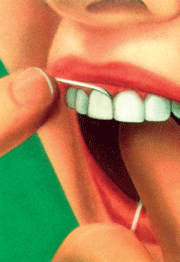 Patient cooperation with daily home care is essential to maintain healthy gums and to keep periodontitis from returning. If good oral hygiene is not yet already undertaken daily by the patient, then twice daily brushing with daily flossing , mouth washing and use of an inter dental brush needs to be started. Technique with these tools is very important. Aged persons may find that use of these inter dental devices more necessary and easier, since the gaps between the teeth may become larger.
Patient cooperation with daily home care is essential to maintain healthy gums and to keep periodontitis from returning. If good oral hygiene is not yet already undertaken daily by the patient, then twice daily brushing with daily flossing , mouth washing and use of an inter dental brush needs to be started. Technique with these tools is very important. Aged persons may find that use of these inter dental devices more necessary and easier, since the gaps between the teeth may become larger.
Professional scraping instruments, such as scalers and currettes are used to remove bacterial plaque and calculus (formerly referred to as tartar) around teeth and below the gum-line. There are devices that use a powerful ultra-sonic vibration and irrigation system to break up the bacterial plaque and calculus. Local anesthetic is commonly used to prevent discomfort in the patient during this process.
Daily oral hygiene measures to prevent periodontal disease include:
• brushing properly on a regular basis (at least twice daily), with the patient attempting to direct the toothbrush bristles underneath the gum-line, so as to help disrupt the bacterial growth and formation of subgingival plaque and calculus.
• flossing daily and using interdental brushes (if there is a sufficiently large space between teeth), as well as cleaning behind the last tooth in each quarter.
• using an antiseptic mouthwash . Chlorhexidine gluconate based mouthwash or hydrogen peroxide in combination with careful oral hygiene may cure gingivitis, although they cannot reverse any attachment loss due to periodontitis. (Alcohol based mouthwashes may aggravate the condition).
• regular dental check-ups and professional teeth cleaning as required. Dental check-ups serve to monitor the person's oral hygiene methods and levels of attachment around teeth, identify any early signs of periodontitis, and monitor response to treatment.
Typically dentists use special instruments to clean (debride) teeth below the gumline and disrupt any plaque growing below the gumline. This is a standard treatment to prevent any further progress of established periodontitis. After such a professional cleaning, bacteria and plaque tend to grow back to pre-cleaning levels after about 3-4 months. Hence, in theory, cleanings every 3-4 months might be expected to also prevent the initial onset of periodontitis.
Nonetheless, the continued stabilization of a patient's periodontal state depends largely, if not primarily, on the patient's oral hygiene at home if not on the go too. Without daily oral hygiene , periodontal disease will not be overcome, especially if the patient has a history of extensive periodontal disease.
Scaling and Root Planing:
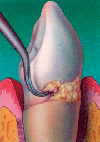
 Periodontal Scaling and Root Planing also known as scaling and curettage is a conservative cleaning procedure. The purpose is to remove hard deposits and infection from beneath the gum and cleanse and clean the root surfaces. Deposits of bacterial plaque, calculus, food debris, and pus that is present in the infected pocket that cause periodontitis are removed. The special instruments plane, clean and smooth the surface of the root. The mouth is numbed with local anesthesia.
Periodontal Scaling and Root Planing also known as scaling and curettage is a conservative cleaning procedure. The purpose is to remove hard deposits and infection from beneath the gum and cleanse and clean the root surfaces. Deposits of bacterial plaque, calculus, food debris, and pus that is present in the infected pocket that cause periodontitis are removed. The special instruments plane, clean and smooth the surface of the root. The mouth is numbed with local anesthesia.
When the causes of the infection are removed, the gum tissues are allowed to heal and become healthy. Non-surgical treatment is usually a very effective treatment which will allow the effected tissues to heal. This is most effective in the early stages of periodontal disease. With good home care and healing time the amount of surgical correction may be reduced.
Medication may be used with treatment that includes scaling and root planing, but they cannot always take the place of surgery. Depending on the severity of gum disease, the dentist may still suggest surgical treatment. Long-term studies will be needed to determine whether using medications reduces the need for surgery and whether they are effective over a long period of time.
Occlusal Adjustment Equilibration:
Occlusal Equilibration corrects and balances excess biting pressures that are associated with loose and shifting teeth and teeth that are hitting too hard or incorrectly. Balancing the biting and chewing forces often allows a loose tooth to tighten.
Periodontal Re-Evaluation:
Periodontal re-evaluation is used to evaluate how a patient responded to either conservative treatment or completed surgery. Re-evaluation is essential to properly access and plans the next stage of treatment and to evaluate a preventive maintenance program.
Regular Recall Appointments:
Dentists "measure" periodontal disease using a device called a periodontal probe. This is a thin "measuring stick" that is gently placed into the space between the gums and the teeth, and slipped below the gum-line. If the probe can slip more than 3 millimeters length below the gum-line, the patient is said to have a "gingival pocket" around that tooth. Pockets are self-cleanable (at home, by the patient, with a toothbrush) if they are 3 mm or less in depth. This is important because if there is a pocket which is deeper than 3 mm around the tooth, at-home care will not be sufficient to cleanse the pocket, and professional care should be sought. When the pocket depths reach 5, 6 and 7 mm in depth, even the hand instruments and cavitrons used by the dental professionals cannot reach deeply enough into the pocket to clean out the bacterial plaque that cause gingival inflammation. In such a situation the pocket or the gums around that tooth will always have inflammation which will likely result in bone loss around that tooth. The only way to stop the inflammation would be for the patient to undergo some form of gingival surgery to access the depths of the pockets and perhaps even change the pocket depths so that they become 3 or less mm in depth and can once again be properly cleaned by the patient at home with his or her toothbrush.
If a patient has 5 mm or deeper pockets around their teeth, then they would risk eventual tooth loss over the years. If this periodontal condition is not identified and the patient remains unaware of the progressive nature of the disease then, years later, they may be surprised that some teeth will gradually become loose and may need to be extracted, sometimes due to a severe infection or even pain.
B: Periodontal Surgery
Conservative, non-surgical, therapy has been recognized as an effective way to control periodontal disease and to allow for natural healing.
If damage is severe and infection is not controlled by conservative treatment, surgery may be required. The damaged support structure, the gum and bone, is reshaped around the tooth. This results in the elimination of pockets.
Patient cooperation with daily home care is essential to maintain healthy gums and to keep periodontitis from returning.
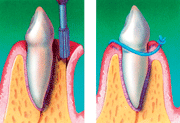 Osseous/Bone Surgery
Osseous/Bone Surgery
Osseous Surgery is used to modify and reshape deformities in the supporting bone around the teeth and is used when periodontal disease is advanced in nature. The bone is modified when indicated and excess gum tissue is trimmed away.
Gingival/Periodontal Grafts
Gingival grafts are designed to replace or enhance the amount of gum surrounding a tooth. This surgery is indicated when there are exposed root surfaces due recession. This procedure is performed when there is not enough gum tissue remaining to help support a tooth. Gingival grafts are also required when excessive recession has occurred exposing the root of the tooth.
Gingival Flap Procedure
Gingival Flap Procedures are required when pockets are very deep and do not heal with conservative therapy. The depth of the pockets do not allow adequate cleaning and elimination of infection. Bone loss is moderate to severe and the gum attachment is lost. Surgical correction is required to eliminate chronic infection. Pockets are moderate to severe. By using a flap procedure access is gained to the root surface bony defects are corrected and inflamed tissue is removed.
Frenectomy
Frenectomy is the surgical procedure for removing a frenum. A frenum is a fold of tissue that passes from the movable lip or cheek to the gum. If a frenum by its position, interferes with the normal alignment of teeth or pulls the gum away from the tooth resulting in recession a surgical procedure is required to remove it.
Gingivectomy/Gingivoplasty
Gingivectomy/ gingivoplasty are surgical procedures that are used to correct the gingiva (soft tissue or gums) that surround the tooth. Deformities are reshaped and reduced. Normal form, health, and appearance are restored to the gum tissues.
Guided Tissue/Bone Regeneration
Guided tissue regeneration is a surgical procedure that utilizes a barrier membrane which is placed under the gum and over the remaining bone. The purpose of the procedure is to enhance and allow for the regeneration of new bone in an area where teeth are being extracted or have already been removed. This surgical procedure is usually done to increase the bony support in an area where a dental implant is about to be placed. The surgery results in an improvement in the shape and contour of the area.

